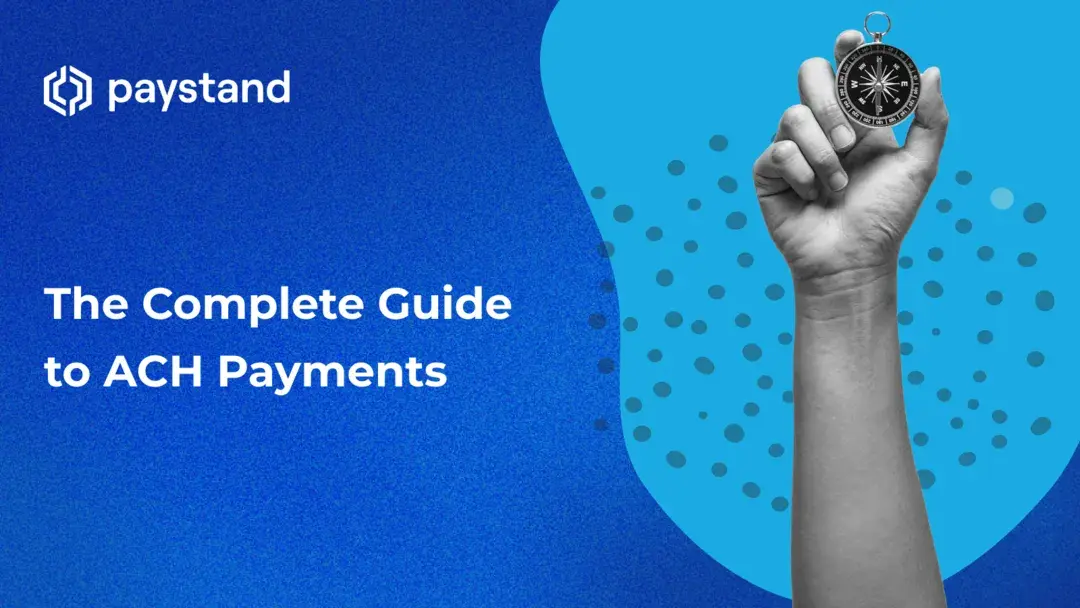The Complete Guide to ACH Payments

Since its founding in the early 1970s, ACH payments have made payment processes between entities easier. They use direct bank account transfers instead of card networks, checks, or cash. ACH's value lies in its fast payment processing, lower fees, and security. Read on to learn more about what is an ACH payment, and how businesses can use the ACH network to their advantage.
What is an ACH Payment?
The Automated Clearing House Network (ACH) is a network that electronically moves money between bank accounts. It is commonly referred to as the ACH network, ACH payment system, or simply as ACH.
Run by the National Automated Clearing House Association (NACHA), the ACH payment system provides transaction services such as payroll, direct deposit, tax refunds, consumer bills, tax payments, and more. The network represents more than 10,000 financial institutions, and in 2021, it saw 29.1 billion payments valued at $72.6 trillion. ACH B2B payments rose 33.2% in the past four years alongside the pandemic.
There are two general B2B transaction types when it comes to ACH payments:
- Corporate Credit or Debit (CCD) — The most popular kind of transaction, a CCD entry, is an ACH transfer used for regular payment processing, such as paying vendors or employees. A company account will originate a single or recurring ACH transaction in a CCD entry.
- Corporate Trade Exchange (CTX) — Used for trading partner payments, a CTX transaction can be either single or recurring.
How do ACH Payments Work, and How are They Used?
ACH payments are electronic payments that allow the payer to send money directly from their bank account to the payee's bank account. Similarly to EFT payments, ACH payments eliminate the need for paper-based payment methods such as traditional checks. ACH payments fall into two categories—direct payments and direct deposits—and are processed in batches by the Automated Clearing House. This can result in delays when receiving funds, so accepting payments via ACH can take 1 to 5 days.
To send money via ACH, the payer must sign an agreement authorizing the payee to withdraw funds against invoices from the payer's account. This happens after the payers make their routing and bank account numbers available to the payees.
The popularity of ACH payments has been rising steadily, and the ACH network saw 29.1 billion payments valued at $72.6 trillion in 2021. Today, ACH payments are used by many institutions, including the following:
- Government entities
- SMBs
- Large enterprises
- Nonprofits
- Financial institutions
The ACH network processes two main categories of transactions: direct deposits and direct payments.
ACH direct deposits are electronic transfers from a business or government organization to a consumer. It is mainly used for payroll, government benefits, tax refunds, and interest payments. In these deposits, the consumer is constantly receiving money.
Individuals and businesses can use direct payments to send money. For example, Using Zelle or Venmo to send money to your friends is an example of direct payment.
In this transaction, the entity sending money incurs an ACH debit in their bank account. On the other hand, the entity receiving the money sees ACH credit in their bank account. The former removes money from an account, while the latter places it into another account.
What Are the Main Benefits of ACH Payments?
Digital payment methods help businesses collect revenue more quickly and securely. They also allow AR departments to avoid the punitive fees incurred by credit card networks (which can be as high as 3.5%) and manual processes like paper checks, which can be subject to long mail float periods that extend DSO and make it difficult for finance teams to predict cash flow.
Digital payment methods, like ACH technology, allow businesses to collect payments more quickly and keep up with the pace of our digital-first world. These methods can significantly impact companies' growth and scale.
1. ACH is a lower-cost solution than accepting card payments
With ACH, money is transferred directly from one account to another, with a median internal cost of $0.29, instead of being handled by expensive card networks, which charge up to 3.5% as a base fee.
2. ACH payments have a low payment failure rate
Compared to card payments, which have a failure rate of 10-15%, ACH payments only have a failure rate of 5%. This number gap is because bank accounts never expire or become lost, so payment failure is significantly reduced.
3. The system supports faster processing times
ACH payments typically take three working days to process and appear in your bank account. Seeing earlier results helps your business regulate and maintain its cash flow and undertake reliable business operations.
4. There is more security with ACH
Unlike other payments, such as checks or credit cards, ACH payments are more secure by eliminating paper processes' potential fraud and error. ACH transactions are never lost in the mail, eliminate intermediaries, and reduce the risk of tampering.
5. Integrate with automated payment collection systems
Most accounting software supports payment collection via ACH Debit, which saves businesses time and money on financial processes. Use automation with the ACH network to allow your business to grow and develop without dealing with payment collection issues.
What Happens if an ACH Payment is Rejected?
If an ACH transaction doesn't go through, you will receive an error code that can be returned to the client. The ACH error codes are:
- R01 - Insufficient funds
- R02 - Bank account is closed
- R03 - Unable to locate the account
- R04 - Reject
Most of these are self-explanatory except for the last code, R04 Reject. In this case, the customer must provide their bank with your ACH Originator ID or enable your business to withdraw from their account.
What Are the Cons of Using ACH?
While ACH payments are preferable to other methods, they also have flaws.
Since the technology and process have stayed the same since the 1970s, ACH payment processing is considered slow by today's standards. For example, even with the arrival of Same-Day ACH, a direct deposit may still take 3-5 days to clear. Furthermore, the process is drawn out because transactions may only be initiated on the following day due to cutoff timings.
ACH payments can only be used with domestic transfers, so cross-border payments require a different solution. A $25,000 cap also limits how much you can send at once.
These cons are relatively inconsequential compared to other payment methods. Luckily, there are ways to improve the process.
ACH With Modern Payment Gateways
A modern AR integration for your ERP system is the key to optimizing ACH payments and increasing the amount of ACH payments you receive.
The right AR payment gateway charges a flat fee based on the volume of transactions. This model can further reduce the amount you may pay per ACH payment but doesn't limit your payment options.
These integrations usually help automate the entire AR process. AR automation creates a stellar customer experience and lowers DSO, and the AR Team benefits from the ease of use and lack of manual data entry work.
Certain features can encourage ACH payments and drive customers away from more costly payments. At Paystand, we call this "Zero-Fee." The concept is simple. Your organization shoulders the cost of the ACH payment, which is significantly less than other transactions, thus making it appear to be "free".
At the same time, you can charge a convenience fee for other costlier methods to shift the burden to the payer. These two features can change customer behavior and encourage more ACH payments.
But at Paystand, we do even more. Customers can save payment details, set up recurring payments, and pay multiple or partial invoices. We also issue an automated, certified receipt for auditability.
Want to learn more about B2B Automation? Explore our specific solution to learn how it can streamline your business processes.






